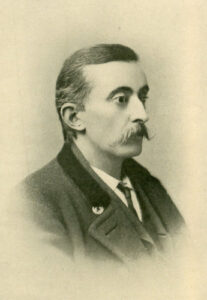
John Dougill writes: This synopsis of a story from Shadowings (1900) is Part Four of a series covering Lafcadio Hearn’s stories set in Kyoto. (For the introduction to the series, mentioning Hearn’s visit to the city, please click here.) The title, ‘O-Kichi-Seiza Kudoki’, was taken by Hearn from a ballad that was sung by wandering biwa players. It features the very Japanese theme of a love suicide.
*******************
‘Now hear the pitiful story of two that died for love,’ begins Hearn. The tale starts in the thread shop of Yoemon, a wealthy Kyoto merchant. One of his daughters, O-Kichi, is a sixteen year old beauty with whom a twenty two year old clerk called Seiza falls in love. Though the mother tries to stop the relationship, O-Kichi is consumed with love, ‘like ink on paper’. So the girl’s father sacks Seiza, who returns to his home in Osaka where he pines for his lost loved one.
One night O-Kichi had a vivid dream of Seiza that was so real she believed he had actually come back to her, but when she woke there was no sign of him. So she went to Osaka in search of his house, where she found his mother weeping copiously. It turned out that he had died just a week before of an illness brought on by his longing for her.
The distraught O-Kichi went to the cemetery where Seiza was buried, and so strong was his desire to be with her that his spirit rose from an opening in the grave and asked her to put flowers before the grave and to arrange Buddhist services on his anniversary days. But she could not stand to be parted from him, and so she filled her sleeves with stones and drowned herself in a moat.
In telling the story Hearn interspersed the brief incidents with the repeated Yanrei!, a chorus taken from the biwa recitals. He annotated the brief tale with explanations and parallels from English literature, making it more of a literary exercise than a simple ghost story. (His encyclopedic knowledge and academic leaning led to a successful spell teaching English Literature at Tokyo University.)
The story reflects Hearn’s fascination with spirits of the dead, as is well-known from the collection in Kwaidan. This has been attributed to his childhood in Dublin, when he claimed to have seen real ghosts. He clung to the belief in adulthood, and adapted it to the evolutionary theories of Herbert Spencer, whom he admired as the greatest man of the age. From Spencer, Hearn got the idea that after death cells dispersed randomly but carried within them memory of their previous existence. It explained for Hearn such mysteries as deja vu and falling in love. In claiming a scientific basis for this, Hearn was thus able to reconcile the romantic and scientific sides of his character.
*************
If you’d like to read the full story, please see this link and scroll down till you reach the title. For previous stories by Hearn set in Kyoto, please see ‘Common Sense‘, ‘Sympathy of Benten‘, or ‘Screen Maiden’.

